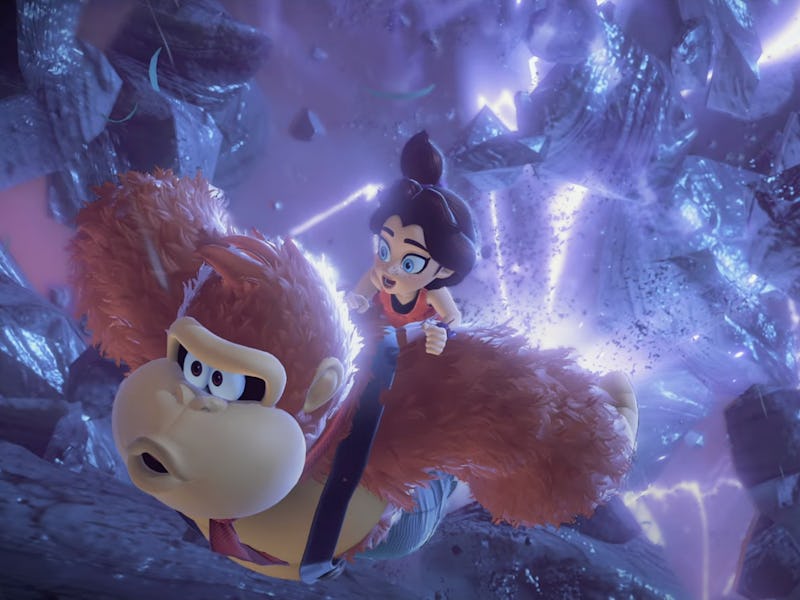Donkey Kong Bananza Improves On Mario Odyssey's Most Obscure Mode
Monkeying around.

Donkey Kong Bananza has a lot going for it. Nintendo’s simian mascot is finally getting some time in the spotlight after 11 years. And his game is the big, non-racing single-player exclusive that the Switch 2 is sorely lacking so close to launch. Everything we’ve seen so far suggests this game will be excellent, and we can’t wait to play more of it.
But while the majority of players will approach Bananza as a single-player romp through a variety of different levels and biomes, it’s not the only way to enjoy the game. There’s a two-player co-op mode I was able to check out in my two hours with the upcoming platformer. And while it's not the first time Nintendo’s done something like this, it's far and away the best implementation for such a feature in a long while.
If you haven’t seen Nintendo’s excellent Direct about Donkey Kong Bananza, let’s catch you up to speed. At any point in Bananza, a second player can join in on the action as Pauline, Donkey Kong’s shoulder-mounted sidekick. As Pauline, players control a cursor and can launch concussive attacks with Pauline’s voice. She can also alter the makeup of these attacks by copying materials in the game world.
In Donkey Kong Bananza, a second player can control a cursor and shoot attacks that deform terrain and harm enemies.
The mode is pretty fun. During my demo, a Nintendo representative played Donkey Kong as I assumed the role of Pauline. As he explored the level, I kept a keen eye out for hard materials that would prove effective in a pinch. Copying a material in the environment grants you eight shots to fire, so that’s a lot of chances to mess with the world around you. It’s very simplistic, but it still required a small amount of communication.
This co-op mode proved to be at its best when we encountered a boss fight. At one point in the demo, we found ourselves fighting a mech controlled by one of the members of the villainous Void Company. As Pauline, I was able to copy parts of the boss’ suit and shoot it back, chipping away at the exterior. After enough hits, the mech’s head was left exposed, allowing my partner to get in close for melee attacks to its most vulnerable part.
Having a single enemy to focus on felt like what this mode was designed for. I can see these scenarios working well even if other enemies jump into these big, destructive battles, as the two players can split offensive responsibilities.
Pauline can have a much more active role in gameplay if you recruit a friend.
I don’t think this is the best way to experience Bananza. When you’re in full control of its main hero, his sense of momentum and unbridled strength is what carries the experience. Being his sidekick didn’t provide that same satisfaction, something that I’m sure was intentional design (she is supposed to be an inexperienced teenager after all). I also found that both players controlling the camera could be disorienting at best and frustrating at worst if their immediate goals don’t align. I imagine playing this mode using GameShare will be the preferred way to engage with it.
That being said, I immediately saw the value of this mode. For parents, older siblings, or even players with non-gaming friends and family, this is a pretty easy and novel way to get others into the game.
If all of this sounds at all familiar, it’s probably because it’s remarkably similar to the optional two-player mode in Super Mario Odyssey. In that game, a second player could control Cappy, spinning in any direction they’d like.
But whereas controlling Cappy in Odyssey felt like a random tacked-on feature, this one felt like a proper way to contribute. Odyssey’s optional second player was relegated to activating and revealing hidden objects in the environment, hitting enemies that were just within Mario’s reach, or assisting in a big jump. In my opinion, this mode always felt like it was delegating tasks far too simple to be interesting to a second player. As a result, the novelty never felt engaging.
GameShare can be used for this co-op mode, allowing a second player to join the session on a second Switch device.
Bananza’s lightgun-type approach to co-op is much more active, giving player two something much meatier to engage with. It feels like a fleshed-out version of the overly simplistic co-op implementation of Super Mario Galaxy, which gave player two the ability to collect coins from a distance, freeze enemies, and fire projectiles.
Nintendo has been trying to make co-op work in its biggest platformers since the Wii generation. But while Galaxy and Odyssey offered overly simple ideas on how to execute this concept to mix results, Bananza provides just enough nuance and control to make it more than a simple distraction. I never played more than a few minutes of Odyssey in co-op with my nephew back in 2017. But I can see his younger sister having a great time with this mode in Bananza in 2025.
While I don’t anticipate many people will be playing through all of Bananza in co-op, it at least offered a much more complete experience over its spiritual predecessors. While it's far from a game-selling feature, it’s another fun novelty being added to one of the year’s best video games.